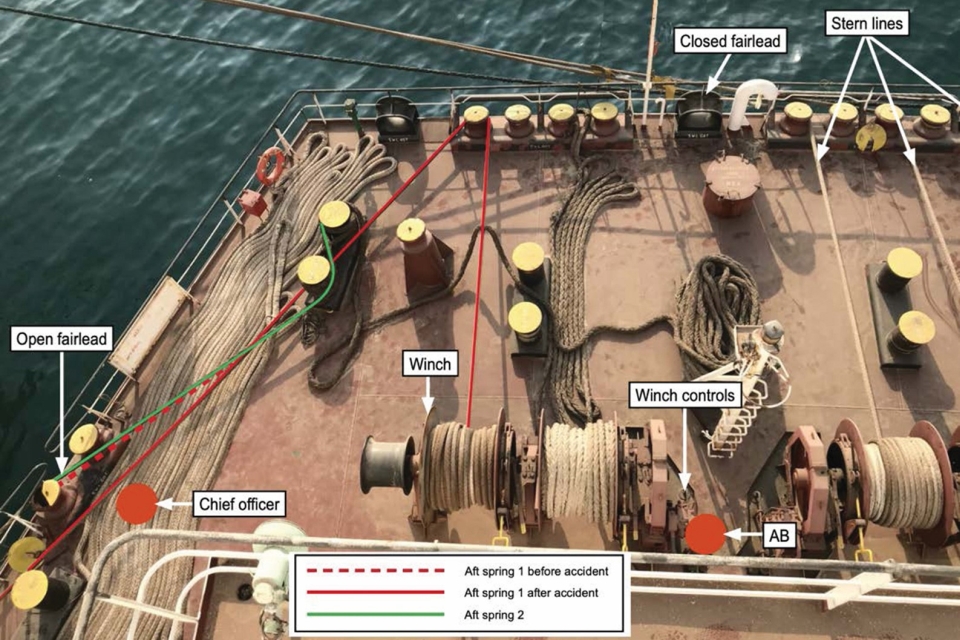While moored under pilotage for a ship-to-ship transfer of cargo, a crew member lost his life after being hit by a mooring line as it snapped tight. The Nautical Institute discusses the incident in its latest Mars Report and warns of the dangers of snapback zones.
The Nautical Institute gathers reports of maritime accidents and near-misses. It then publishes these so-called Mars Reports (anonymously) to prevent other accidents from happening. A summary of this incident:
A bulk carrier had arrived at an anchorage to load a cargo of grain from an anchored bulk carrier which was acting as a grain storage vessel. The vessel was moored under pilotage alongside the anchored storage vessel and prepared for the ship-to-ship (STS) transfer of cargo.
The mooring arrangement agreed between the master and pilot consisted of three head lines, three stern lines, two forward springs and two aft springs; all lines belonged to the receiving vessel. Loading commenced using the storage vessel’s crane grabs. At this time the two vessels had similar freeboard.
Some 22 hours later, with loading near eighty percent complete, the forward crane operator on the storage vessel advised his duty officer that the receiving vessel needed to be moved forward to allow the crane grab to reach part of the hold he was loading. By this time, the storage vessel’s deck was about eight metres higher than that of the receiving vessel.
The three crew on watch and the chief officer of the receiving vessel manned the forward and aft mooring decks to warp the vessel forward using the spring lines. The master decided not to wake the off watch crew to assist as this would disrupt their hours of rest.
Also read: ‘Treat mooring lines as you would a loaded gun’
Mooring line springs out of open roller fairlead
On the aft mooring deck, the chief officer was standing close to the vessel’s side with the other crew standing by the winch ready to heave in the aft spring. As the forward springs were slackened, the winchman aft began to haul in on one of the aft springs to heave the vessel forward. Almost as soon as the mooring line came under tension, it sprang out of its open roller fairlead and struck the chief officer’s head as it snapped tight. The victim fell unconscious to the deck.
The accident was immediately announced and the victim attended to. He was lying unresponsive on the deck, but with no visible injuries; he was breathing, and a pulse was observed. The victim was evacuated ashore via a tug, but by this time his condition had deteriorated and his pulse had weakened. Later the victim was declared deceased having suffered closed blunt force trauma to the head, traumatic swelling of the brain and a brain haemorrhage.
Also read: Nautical Institute: Stay out of the ‘line of fire’ when working with mooring lines
Investigation findings
The accident investigation found, among other things, that the chief officer was standing in a hazardous location, but, almost certainly, had not appreciated the risk of the spring line jumping out of the fairlead.
The investigation also found that, although the chief officer’s working hours were compliant with STCW requirements, he was likely to have been in a fatigued state. This may have influenced his actions and motivated him to complete the job quickly so he could rest.
Also read: ‘Safe working with mooring lines needs a turnaround in thinking’
Advice from The Nautical Institute
- An operation to shift a vessel involved in an STS transfer should be assessed for the development of potential new hazards over the course of the operation – for example, the change in relative vertical reference due to draught changes of each vessel.
- During STS transfer operations, mooring lines will develop increasingly vertical leads as the discharging vessel’s freeboard rises and that of the loading vessel falls. To ensure containment of mooring lines that have or develop more vertical leads, closed fairleads should be used.
- Always evaluate your physical position at a mooring station and stay clear of potential snap-back or other energy release zones.
- Compliance with STCW work/rest requirements does not guarantee a person is not fatigued. Each individual is responsible for ensuring their own sleep hygiene is adequate.
Mars Reports
This accident was covered in the Mars Reports, originally published as Mars 202401, that are part of Report Number 375. A selection of the Mars Reports are also published in the SWZ|Maritime magazine. The Nautical Institute compiles these reports to help prevent maritime accidents. That is why they are also published (in full) on SWZ|Maritime’s website.
More reports are needed to keep the scheme interesting and informative. All reports are read only by the Mars coordinator and are treated in the strictest confidence. To submit a report, please use the Mars report form.








